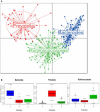Enterotype May Drive the Dietary-Associated Cardiometabolic Risk Factors
- PMID: 28280715
- PMCID: PMC5322172
- DOI: 10.3389/fcimb.2017.00047
Enterotype May Drive the Dietary-Associated Cardiometabolic Risk Factors
Abstract
Analyses of typical bacterial clusters in humans named enterotypes may facilitate understanding the host differences in the cardiometabolic profile. It stills unknown whether the three previously described enterotypes were present in populations living below the equator. We examined how the identification of enterotypes could be useful to explain the dietary associations with cardiometabolic risk factors in Brazilian subjects. In this cross-sectional study, a convenience sample of 268 adults (54.2% women) reported their dietary habits and had clinical and biological samples collected. In this study, we analyzed biochemical data and metagenomics of fecal microbiota (16SrRNA sequencing, V4 region). Continuous variables were compared using ANOVA, and categorical variables using chi-square test. Vsearch clustered the operational taxonomic units, and Silva Database provided the taxonomic signatures. Spearman coefficient was used to verify the correlation between bacteria abundances within each enterotype. One hundred subjects were classified as omnivore, 102 lacto-ovo-vegetarians, and 66 strict vegetarians. We found the same structure as the three previously described enterotypes: 111 participants were assigned to Bacteroides, 55 to Prevotella, and 102 to Ruminococcaceae enterotype. The Prevotella cluster contained higher amount of strict vegetarians individuals than the other enterotypes (40.0 vs. 20.7 and 20.6, p = 0.04). Subjects in this enterotype had a similar anthropometric profile but a lower mean LDL-c concentration than the Bacteroides enterotype (96 ± 23 vs. 109 ± 32 mg/dL, p = 0.04). We observed significant correlations between bacterial abundances and cardiometabolic risk factors, but coefficients differed depending on the enterotype. In Prevotella enterotype, Eubacterium ventriosum (r BMI = -0.33, p = 0.03, and r HDL-c = 0.33, p = 0.04), Akkermansia (r 2h glucose = -0.35, p = 0.02), Roseburia (r BMI = -0.36, p = 0.02 and r waist = -0.36, p = 0.02), and Faecalibacterium (r insulin = -0.35, p = 0.02) abundances were associated to better cardiometabolic profile. The three enterotypes previously described are present in Brazilians, supporting that those bacterial clusters are not population-specific. Diet-independent lower LDL-c levels in subjects from Prevotella than in other enterotypes suggest that a protective bacterial cluster in the former should be driving this association. Enterotypes seem to be useful to understand the impact of daily diet exposure on cardiometabolic risk factors. Prospective studies are needed to confirm their utility for predicting phenotypes in humans.
Keywords: cardiometabolic risk; diet; enterotype; gut microbiota; lipid profile.
Figures



References
-
- Al-Jashamy K., Murad A., Zeehaida M., Rohaini M., Hasnan J. (2010). Prevalence of colorectal cancer associated with Streptococcus bovis among inflammatory bowel and chronic gastrointestinal tract disease patients. Asian Pac. J. Cancer Prev. 11, 1765–1768. - PubMed
Publication types
MeSH terms
Substances
LinkOut - more resources
Full Text Sources
Other Literature Sources
Medical

